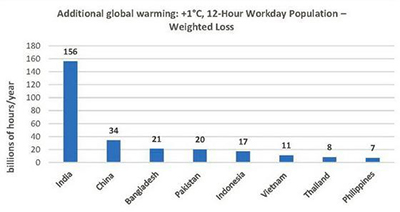Relevance: GS-3: Conservation, environmental pollution and degradation, environmental impact assessment.
Key Phrases: Nature Communications, heat exposure, labour productivity, International Labour Organisation, Heat stress, South Asia Heat Health Information Network, Global Health Information Network.
Why in News?
- A recent study published in ‘Nature Communications’highlighted that India is the most impacted country with the largest heat exposure to labour productivity.
Key findings of the report:
- It loses labour productivity of more than 100 billion hours per year while the global sum is 220 billion hours.
- Comparable losses in China, Bangladesh, Pakistan, Indonesia, Vietnam, Thailand, and the Philippines are relatively much less.
- With an additional 1 to 2-degree warming; the labour productivity losses go up to 156 and 230 billion hours, respectively, in India.

Labour productivity loss due to heatwaves in high-risk countries
Heat stress
- Heat stress refers to heat more than what the body can tolerate without suffering physiological impairment.
- It generally occurs at temperatures above 35°C, in high humidity.
- Excess heat during work is an occupational health risk; it restricts workers’ physical functions and capabilities, work capacity and thus, productivity.
- In extreme cases it can lead to heatstroke, which can be fatal.
Losses of up to $311 billion
- The International Labour Organisation estimates that labour productivity losses associated with reductions in work rate due to heat exposure can be as high as $280-311 billion per year.
- These are mostly attributed to losses in low- and middle-income countries including those in South Asia in sectors involving heavy manual labour such as agriculture and construction.
- The South Asia Climate Outlook Forum had released a consensus statement on the Seasonal Climate Outlook for the 2022 Southwest Monsoon Season (June-September).
- Translating the seasonal climate outlook to impact forecasting, the UN-ESCAP had identified hotspots of the vulnerable population likely being exposed to low precipitation and high temperature.

Labour productivity loss due to heatwaves across countries - impact from additional global warming
Sub-regional pathway:
- Sub-regional initiatives such as the South Asia Heat Health Information Network and the Global Health Information Network, a joint venture of the World Health Organisation and the World Meteorological Organisation, are building blocks of a sub-regional pathway.
- UN-ESCAP’s Risk and Resilience Portal, an initiative of the Asia-Pacific Disaster Resilience Network, is also an effort to strengthen such sub-regional pathways for adaptation to heatwaves and help build a resilient future for all.
Policy and Institutional arrangements required:
- Countries should consider ratifying and implementing relevant international labour standards to ensure decent working conditions for workers and businesses affected by heat stress;
- Governments should adopt regulations laying down maximum temperatures to which workers may be exposed at work, and provide for specific measures to protect workers from high temperatures;
- Infrastructure-related measures, such as building standards, should be adopted to enhance the protection of indoor workers;
- The fact that heat stress is a driver of migration needs to be recognized in regulatory frameworks established to ensure safe migration;
- Social protection systems, including the provision of social insurance and social assistance, can help workers and their families (particularly in developing countries) to adapt to the consequences of heat stress;
- Whether at the level of individual companies, economic sectors or the country as a whole, social dialogue, as a key part of the institutional framework for policy-making and policy implementation, can ensure that the impact of heat stress on working conditions is addressed effectively.
Conclusion:
- Efforts to limit global warming can help significantly to prevent further increases in heat stress levels.
- Since projected temperature increases up to 2030 depend largely on the accumulation of past GHG emissions, the world of work would have to adapt to heat stress.
- The challenges identified in this report point to the urgent need to understand better how such adaptation might be achieved.
- In particular, focusing on vulnerable groups of workers and the countries, most affected by heat stress would help to identify specific priority actions that should be undertaken by governments and by employers’ and workers’ organizations.
Source: The Hindu BL
Mains Question
Q. What are the impacts of heat exposure on labour health and productivity and how India should deal with it?








